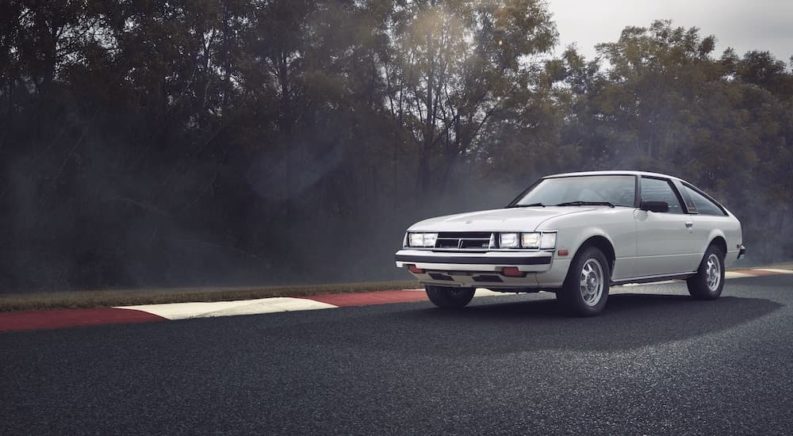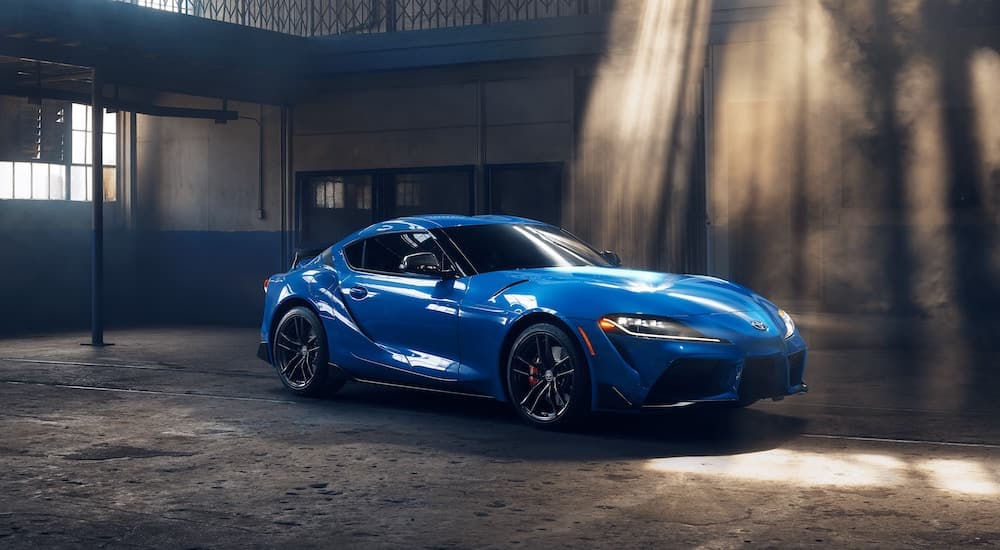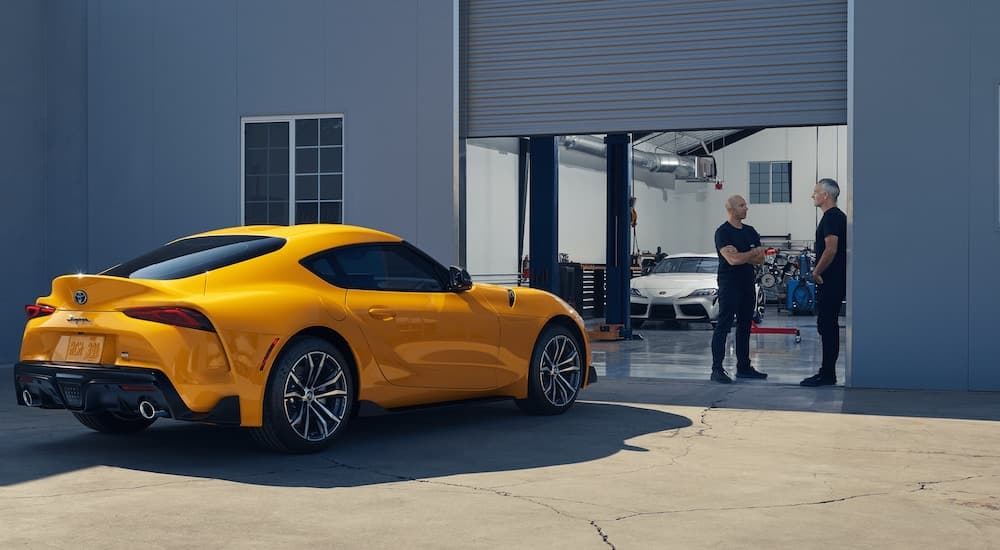You may have seen one around town, especially since it’s been on the scene since the late 1970s. Or you may recall being mystified by it on the silver screen in the chart-topping Fast & Furious franchise. The Toyota Supra has been stirring up thrills for decades, but if you thought it’s always been an icon, you’d better think again. This powerhouse had simple beginnings and had to work to get to where it is today, making its victories even sweeter. Passing by your local Toyota dealer, you may feel tempted to take one for a spin, and we certainly wouldn’t blame you, but if you’d rather sit back and take a virtual test drive through time, we can make that happen.
Supra’s Early Years
Like many automotive icons, the Supra began as a simple trim level, and in this case, the Supra trim was found on Toyota’s sporty Celica model. Displaying the Supra badge meant the car was equipped with a high-performance inline-six engine. It was a larger engine than the standard Celica inline-four, which meant that the Celica Supra had to be revamped in order to accommodate it, accomplished by extending the wheelbase and updating the front end. The Celica Supra quickly achieved what engineers designed it to do, which was to add excitement to the journey, accelerating from 0-60 mph in 11.2 seconds, impressive for the time. Although it performed better than traditional sedans of the era, it wasn’t quite performance car material, but that would come in time.
The 1980s brought more performance-based features to the Celica Supra, and in 1986, the Supra became a model all its own. A bit more cumbersome than previous models, yet still sporting a powerful inline-six engine and rear-wheel drive, the new Supra was poised to impress. Pop-up headlights, eye-catching rear spoiler, and more dramatic elements allowed the Supra to evolve into the car it was meant to be. It was clear that once it became its own model, drivers really began to see changes on the horizon.
Surpassing the Competition, and an Early Demise
Toyota decided to outfit the Supra with a turbocharger for the third generation, further amplifying its performance on the track and beyond. Now, this wannabe racer oozed exhilaration, making 230 hp and improving its 0-60 mph time to 6.4 seconds. A few years later, in 1993, the Supra really began to catch the attention of more drivers interested in performance vehicles. Its brand-new design showcased an athletic stance with sleek, sculpted elements, setting itself apart from the traditional Toyota lineup. With enhancements to its performance, the Supra’s trademark inline-six continued to excel, launching the fourth-generation car from 0-60 mph in a cool 5.3 seconds.
Not only did the Supra look ultra-cool, but its performance was astonishing, and it seemed as though nothing could stop this Toyota speedster from dominating the industry. Unfortunately, interest in the Supra began to wane in the mid-1990s, as other competitors were beginning to surpass its abilities. Toyota made the tough call to end sales in the American market in 1998, and the Supra was set to become a relic of the past, much like many others that came before it. Supra fans were disappointed, but the sales had spoken, and Toyota wasn’t seeing the return it desired for this particular model. Such is life…
Too Fast, Too Furious
In 2001, a film debuted that changed the industry forever. The Fast and The Furious raked in over $207 million at the box office, becoming the highest-grossing movie of the year. Fast cars, tons of adrenaline, and an all-star cast made the film an instant success and included in the film’s vehicle arsenal, you ask? The Toyota Supra, of course.
The late Paul Walker took his place behind the wheel of a 1994 Supra, catapulting this icon to absolute greatness. It seemed all was not lost for this legendary Toyota model, after all, prompting fans to regain their optimism that Toyota would bring back the Supra. If you’re wondering why a 1994 model was chosen for the film, there are many reasons. Its appearance was exactly what the Fast & Furious franchise was looking for––an aerodynamic design, vibrant colors, and plenty of racing swagger emanating around it. It not only looked the part but also performed past expectations, topping out at 185 mph in the film.
The Supra went on to appear in subsequent installments, including 2 Fast 2 Furious in 2003 and Furious 7 in 2015, with the entire franchise debuting a total of nine movies (with one on the way), earning over $6 billion at the box office. At the center of it all sat a not-so-humble fiery orange Toyota Supra, solidifying its place as one of the most fascinating vehicles of all time. Who would have thought that a car no longer on the market could make a comeback this iconic?
It’s Back, Baby!
The Fast & Furious franchise collected a loyal fanbase across the globe, and so did the Supra. In 2020, the US saw its first new Supra in over two decades, and the industry was pulsing with excitement. With jaw-dropping performance, coupled with classic Supra style, the 2020 Supra wasted no time repositioning itself in line with the greats. Toyota chose to stick with its inline-six, paired with an 8-speed automatic transmission. It jolted from 0-60 mph in an astounding 3.8 seconds, proving that its hibernation only seemed to enhance it.
Today, the Supra is regarded as one of the best sports cars on the market. Now rocking the GR badge for Toyota Gazoo Racing, the Supra has been put to the test, delivering on all fronts when it comes to an adrenaline-packed performance. It’s a thrill to drive, showcases a comfortable cabin, and its style is simply untouchable. For the upcoming 2023 Supra, drivers will once again have the option of a six-speed manual, which is a godsend for many racing enthusiasts. New models also showcase a fine-tuned suspension system and more refined steering to further influence the spirit of the drive.
Not only is the Supra an expert racer on the track, but its dynamic ride makes it smooth and controlled enough to be an ideal everyday traveler. Inside, its cabin is elevated with sporty style and plenty of headroom and legroom for all to enjoy a comfortable ride. Outside, its legendary design often induces double-takes from passersby with its timeless aerodynamic elements and hypnotic LED lighting. All in all, it’s a well-rounded vehicle that appeals to a versatile array of drivers, and we have a feeling that it’s not done wowing us yet.
The Sensational Supra
There’s no doubt about it, one ride in the Supra, and you’ll be taken aback by its uncanny ability to thrill you, even on the most mundane roadways. Debuting as a mere trim level in the 1970s and evolving into one of the most exciting sports cars in the industry, the Supra is full of adrenaline-packed surprises, and we’re here for it. Being pulled from the market in the 1990s, only to resurface as a Hollywood icon, the Supra is a testament that you should never give up, and due to its claim to fame, Toyota chose to bring it back for the modern world. It just goes to show that a great car won’t be overshadowed and won’t be held down by a setback. When a vehicle is as impressive as the Supra, people are bound to take notice. The Toyota Supra has a celebrated history, and we have no doubt that it will continue to revolutionize the industry with its future endeavors.






